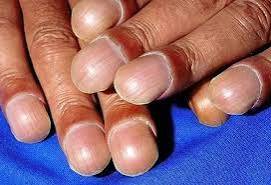Clubbing
Clubbing refers to changes in the shape and texture of the fingers or toes and their nails. It is often a sign of underlying systemic or chronic diseases. Clubbing typically involves the soft tissue under the nails becoming thickened, resulting in a bulbous appearance.
---
Causes
Clubbing is usually associated with chronic low oxygen levels in the blood or other systemic diseases:
1. Respiratory Conditions
Chronic obstructive pulmonary disease (COPD).
Lung cancer.
Cystic fibrosis.
Tuberculosis.
Pulmonary fibrosis (scarring of lung tissue).
2. Cardiovascular Conditions
Congenital heart defects.
Infective endocarditis (heart valve infection).
Cyanotic heart disease (causes low oxygen levels in the blood).
3. Gastrointestinal and Liver Diseases
Cirrhosis.
Inflammatory bowel disease (e.g., Crohn’s disease, ulcerative colitis).
4. Other Causes
Hyperthyroidism (rare).
HIV/AIDS.
Genetic predisposition (primary clubbing).
---
Signs and Symptoms
1. Nail and Finger Changes:
Curved nails with a convex shape.
Thickened fingertips or toes.
Nails appear to float over the nail bed.
2. Angle Changes:
The angle between the nail and the cuticle (Lovibond angle) exceeds 180°.
3. Softening of Nail Beds:
Nail beds become spongy or softer to the touch.
4. Other Physical Symptoms:
Clubbing may be painless, but it is often associated with symptoms of the underlying condition (e.g., shortness of breath, fatigue).
---
Effects
1. Cosmetic Concerns:
The appearance of fingers and nails may cause emotional distress.
2. Underlying Disease Progression:
Clubbing itself is not harmful, but it signals serious health issues that require attention.
3. Functional Impairment:
In severe cases, nail curvature may interfere with daily tasks like gripping objects.
4. Health Risks:
Untreated underlying conditions (e.g., lung or heart disease) can lead to complications or worsen over time.
---
Solutions
1. Diagnose and Treat the Underlying Cause
Lung Conditions:
Oxygen therapy for conditions like COPD or pulmonary fibrosis.
Antibiotics or antifungals for infections like tuberculosis.
Heart Conditions:
Surgical repair for congenital heart defects.
Treat endocarditis with appropriate antibiotics.
Liver and Gastrointestinal Issues:
Manage cirrhosis, Crohn’s disease, or ulcerative colitis with medications and lifestyle changes.
2. Symptom Management
Quit Smoking: Smoking exacerbates respiratory and cardiovascular conditions.
Balanced Diet: Support overall health with proper nutrition.
Physical Activity: Enhance circulation and lung capacity (as advised by a doctor).
3. Medical Follow-Up
Regular monitoring of the underlying condition is essential to prevent worsening.
Seek immediate medical attention if new symptoms (e.g., pain, swelling, or difficulty breathing) arise.
---
Key Takeaways
Clubbing is not a disease but a symptom of serious underlying health problems.
Prompt diagnosis and treatment of the root cause are critical.
Clubbing may improve or reverse if the underlying condition is treated effectively.


